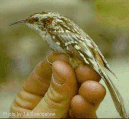Bird Rehab

In this month's Conscious Choice, Susan DeGrane writes about Chicago's Bird Rehabilitation Center which opened April 1 in a Chicago Park District building at 1400 S. Lynn White Drive on Northerly Island. Located east of the Chicago skyline, the 91-acre peninsula that juts into Lake Michigan contains lush open prairie and parkland once occupied by the Meigs Field airstrip.
The center started with six volunteers and plans call for adding another or so before summer's end, said Dawn Kelly, director of Flint Creek Wildlife Rehabilitation, Inc. Flink Creek, a not-for-profit with a primary location in Barrington, has an agreement with the Park District to operate the facility.
If you find an injured or abandoned bird in Chicago, call the Flint Creek number: 847.602.0628. Animals are accepted by appointment only.
"Many people jump the gun when it comes to taking in injured, fallen, or seemingly abandoned birds. In many cases, the mother birds are nearby. It's much better to allow them to come to the rescue, " Kelly explained.
"If a bird is not in any immediate danger, it's best to leave it alone, but certainly if a bird is on the sidewalk and there's the threat of it [being in greater danger], it's good to put it in a box and keep it in a dark, quiet place," she said.
DeGrane writes that of the 80 or so birds taken in during those first two weeks, most suffered head trama. Only a few had broken wings or legs. Some were well enough to be on their way in just a couple of days.
"We released at least one bird a day, sometimes as many as a dozen in one day, depending on how quickly they recovered," Kelly said. "One morning I was releasing a brown creeper. I had just released several brown creepers earlier. He made this beautiful brown creeper sound, and brown creepers started calling out to him all around the peninsula. So he got to be with his buddies."
June brings the stragglers from most migrating species and several warblers, including Tennessee warblers, common yellow-throated warblers and others known for their brilliant plumage and beautiful songs. "As we progress through the migratory season, the composition of those we treat will change," Kelly said. "It's kind of nice that they grace us with their presence for a while," she said.
For more information, visit www.flintcreekwildlife.org.
Photo of Brown Creeper (Certhia americana) credit: JA Spendelow, US Geological Survey

0 Comments:
Post a Comment
<< Home